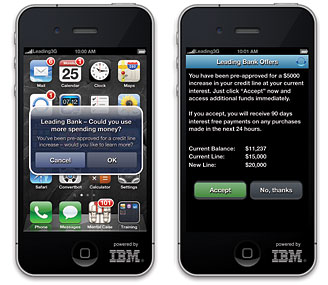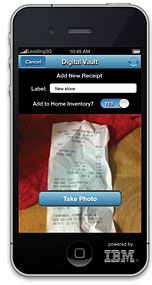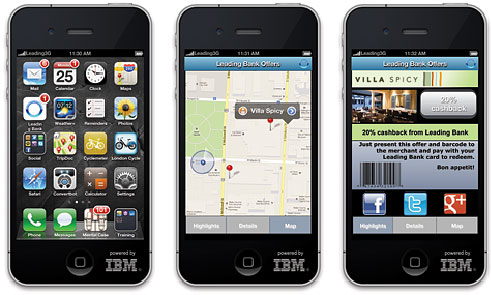Retail financial institutions have always enjoyed access to a volume of consumer data that would make other industries drool with envy. The huge streams of information flowing from customers’ account activity has afforded a level of insight and analysis seldom possible outside the banking sector. Now, with the advent of big data tools and technologies, IBM says banks and credit unions have the ability to understand consumers in even greater depth and predict their needs by analyzing the wealth of data available today.
In a white paper released by IBM, the tech giant argues that financial institutions can leverage big data for the kind of insight needed to deliver more personalized products and services, and in real time. For example, most banks and credit unions have lacked the analytical capability to examine any correlation between the timing of purchases — when someone buys groceries, do they also buy fuel for their car? That data has always been there, but now the tools necessary to make sense of it are more readily available.
Financial institutions can now capture and analyze larger volumes of data from a variety of sources, including social media, web traffic, online behavioral patterns and transactional information. For instance, IBM says a bank’s frontline staff can now derive insight from free-form notes generated in the contact center, and take action in real time. This approach empowers financial marketers; they can monitor consumer behavior, update their campaigns and deliver relevant, offers in context, and do so immediately.

The Power of Localized Marketing in Financial Services
Learn how to enhance your brand’s local visibility, generate more leads, and attract more customers, all while adhering to industry regulations and compliance.
Read More about The Power of Localized Marketing in Financial Services

How Banks Are Fortifying Their Data Against Increasing Cyber Threats
This webinar from Veeam will detail the value of working together across your organization to be better prepared in cyber defense and response readiness.
Read More about How Banks Are Fortifying Their Data Against Increasing Cyber Threats
Building a Smarter Digital Banking Strategy
Consumers today are interacting with banking providers through multiple touchpoints, but the massive surge in the mobile channel is driving financial institutions to adopt a digital-first strategy — a direction that could help them make the most of big data.
This means banks and credit unions must move beyond mobile banking as a mere destination — one more place to go for routine transactions such as balance inquiries or payments. Instead, IBM says mobile banking must be seen as an interactive service that works more broadly with consumers, based on their needs. In the mobile channel, banks and credit unions have new opportunities to interact with customers during their day-to-day banking experiences — even more so than in the past, when any question or need meant a trip to the branch. With big data analytics, banking providers should be better poised to predict each customer’s most-likely actions, and determine their best response.
Key Insight: If you can anticipate consumers needs faster than your competition, you are more win your marketing battles.
But before banks and credit unions can realize the promise of big data, IBM says they will first need to expand their capabilities — how to capture and manage data from a vast array of sources, then translate it into marketing and business strategy.
Big Data Applied: What’s It Mean to Peter?
What does the intersection of big data and mobility look like at a street level? Let’s consider how it might look to Peter, a fictitious persona created by IBM to illustrate the potential power of modern analytics in the everyday lives of ordinary consumers.
Peter and his wife have just bought a home with a mortgage from Acme Bank. They recently decided to remodel. An avid cook, Peter heads out on a weekend morning and buys a set of chef’s knives for the new kitchen using his Acme Bank card.
Acme Bank’s system recognizes that Peter is making a purchase potentially related to his home and analyzes his available financial data — including spending patterns, income, savings balance, available credit, loans, credit score and level of risk. The system also analyzes his related activity on social media and discovers that Peter loves to cook, enjoys gourmet restaurants, blogs about his dining experiences and “would love to have a new, restaurant-style, six-burner gas stove.”
Based on Peter’s experiences, IBM outlines five key capabilities banks and credit unions must master in order to leverage big data.
Key Capability #1: Create marketing opportunities from big data using detailed analyses of consumer-specific spending patterns. With predictive analytics analyzing a variety of data about Peter, Acme Bank anticipates similar home-related purchases while also recognizing that Peter is nearing his credit limit. To capture/keep Peter’s business before he decides to get a(nother) credit card, Acme Bank extends his line of credit, sending an opt-in offer to his smartphone. He reviews and accepts the terms using with the tap of a finger, and viola — his home equity line has a new, higher limit. With a more detailed understanding of customers like Peter, IBM says financial institutions can make more granular and accurate risk assessments when evaluating credit decisions. Banks and credit unions can choose a set of terms including credit limits, optimized for both the individual and the institution; offers become more tailored, and the experience becomes more personalized.

An extension of credit based on real-time activity and historical analysis of spending, offered in real time and delivered via smartphone.
 Key Capability #2: Content analytics and content management for OCR analysis and text analytics. Acme Bank’s analytics system knows Peter has just made a significant purchase, so the bank suggests he store his receipt in their Digital Vault. Using this free service, Peter can take a picture of important documents and keep them safely in a bank database for future retrieval. As Peter uploads the receipt for his new stove into the Digital Vault, optical character recognition (OCR) technology recognizes this as a home appliance and offers him an extended warranty. Peter accepts and purchases the warranty on his new appliance.
Key Capability #2: Content analytics and content management for OCR analysis and text analytics. Acme Bank’s analytics system knows Peter has just made a significant purchase, so the bank suggests he store his receipt in their Digital Vault. Using this free service, Peter can take a picture of important documents and keep them safely in a bank database for future retrieval. As Peter uploads the receipt for his new stove into the Digital Vault, optical character recognition (OCR) technology recognizes this as a home appliance and offers him an extended warranty. Peter accepts and purchases the warranty on his new appliance.

Key Capability #3: Using past behaviors, patterns and preferences to personalize marketing messages at the individual level with geographical proximity. Previously, Peter opted into Acme Bank’s merchant-funded rewards program, a service that gives him discounts with many of the bank’s small business customers. Analyzing Peter’s regular lunchtime purchase patterns and preferences, the bank sends him a personalized offer from Villa Spicy, a restaurant and customer of Acme Bank. The analysis is based on time of day, location, past purchase history and promotional appeal (e.g., cash back vs. points). The offer appears on Peter’s smartphone.

Real-time, location-based merchant offers driven by historical spend analysis. Targeted alerts present a lunch discount offer and a map showing the location of the restaurant.
Key Capability #4: Empowering consumers with insights derived from big data analyses. Peter is looking at his account through on his tablet. Under the “My Offers” tab, he sees that the bank is offering him its Smart Sweep service. Peter wants to learn more about Smart Sweep, so he starts a video chat on his tablet. A video window pops up, and Peter is greeted by a bank customer service representative. The rep explains that Smart Sweep is an account that automatically transfers a specified amount into a higher interest-earning investment option according to a specified schedule.
But how much should Peter allocate if he chooses to participate in an automatic savings program? That’s where IBM says big data can play a role. Rather than just leverage big data to make decisions internally, banks and credit unions can share insights they tease out of their data to help consumers make better, more informed decisions. Based on what Acme Bank has learned analyzing how other customers have used its Smart Sweep service, the bank is able to suggest an amount Peter can comfortably afford to transfer every month.
Key Capability #5: Integrating anonymized, aggregated customer data to create offers for “people like you.” While Peter is logged into Acme Bank’s mobile platform, he also takes a look at the bank’s Spending Manager module, a feature that allows him to see how his spending has changed from month to month. Peter can also compare his spending habits to peers in his geographic location, income and age bracket. With the ability to compare individuals with their financial peers, Acme Bank can generate “people like you” offers, based on any number of criteria ranging from payment/deposit history, shopping trends, spending patterns, lifestyle/lifestage, personal preferences, and a multitude of geo-demographic factors.

The Financial Brand Forum Kicks Off May 20th
Explore the big ideas, new innovations and latest trends reshaping banking at The Financial Brand Forum. Will you be there? Don't get left behind.
Read More about The Financial Brand Forum Kicks Off May 20th

Navigating the Role of AI in Financial Institutions
83% of FI leaders agree investing in AI is essential for 2024 but how you leverage AI is instrumental in success and meeting customer expectations.
Read More about Navigating the Role of AI in Financial Institutions
Expanding Digital Banking’s Value Proposition
With help from big data analytics, banking providers can develop new products and services, and deliver them in new ways that are more proactive. But financial marketers will need what IBM calls “cost-effective horsepower” to perform these complex personal spending analyses across their entire base. IBM says this goes way beyond basic segmentation. It’s not just about creating broad categories of spending ranges and behaviors encompassing groups of consumers, but understanding each customer at the individual level. Achieving insight across multiple individual customer dimensions with this level of granularity requires “technological economies of scale that are not possible with traditional warehousing approaches.”
But if retail financial institutions can master these new critical data analytics capabilities, they can radically transform the customer experience, helping people manage their finances, save money, simplify banking and make daily life easier. With a smarter digital banking strategy that combines mobile tech with big data, banks and credit unions will be better positioned to enhance the customer experience, improve satisfaction scores and increase retention rates while generating additional revenue.







